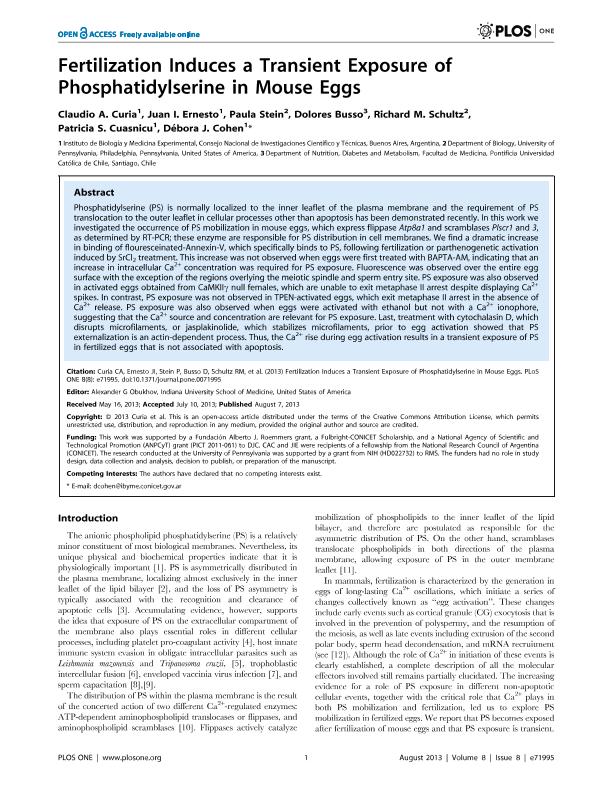Artículo
Fertilization induces a transient exposure of phosphatidylserine in mouse eggs
Curia, Claudio Augusto ; Ernesto, Juan Ignacio
; Ernesto, Juan Ignacio ; Stein, Paula; Busso, Dolores; Schultz, Richard; Cuasnicu, Patricia Sara
; Stein, Paula; Busso, Dolores; Schultz, Richard; Cuasnicu, Patricia Sara ; Cohen, Debora Juana
; Cohen, Debora Juana
 ; Ernesto, Juan Ignacio
; Ernesto, Juan Ignacio ; Stein, Paula; Busso, Dolores; Schultz, Richard; Cuasnicu, Patricia Sara
; Stein, Paula; Busso, Dolores; Schultz, Richard; Cuasnicu, Patricia Sara ; Cohen, Debora Juana
; Cohen, Debora Juana
Fecha de publicación:
07/08/2013
Editorial:
Public Library of Science
Revista:
Plos One
ISSN:
1932-6203
Idioma:
Inglés
Tipo de recurso:
Artículo publicado
Clasificación temática:
Resumen
Phosphatidylserine (PS) is normally localized to the inner leaflet of the plasma membrane and the requirement of PS translocation to the outer leaflet in cellular processes other than apoptosis has been demonstrated recently. In this work we investigated the occurrence of PS mobilization in mouse eggs, which express flippase Atp8a1 and scramblases Plscr1 and 3, as determined by RT-PCR; these enzyme are responsible for PS distribution in cell membranes. We find a dramatic increase in binding of flouresceinated-Annexin-V, which specifically binds to PS, following fertilization or parthenogenetic activation induced by SrCl2 treatment. This increase was not observed when eggs were first treated with BAPTA-AM, indicating that an increase in intracellular Ca2+ concentration was required for PS exposure. Fluorescence was observed over the entire egg surface with the exception of the regions overlying the meiotic spindle and sperm entry site. PS exposure was also observed in activated eggs obtained from CaMKIIγ null females, which are unable to exit metaphase II arrest despite displaying Ca2+ spikes. In contrast, PS exposure was not observed in TPEN-activated eggs, which exit metaphase II arrest in the absence of Ca2+ release. PS exposure was also observed when eggs were activated with ethanol but not with a Ca2+ ionophore, suggesting that the Ca2+ source and concentration are relevant for PS exposure. Last, treatment with cytochalasin D, which disrupts microfilaments, or jasplakinolide, which stabilizes microfilaments, prior to egg activation showed that PS externalization is an actin-dependent process. Thus, the Ca2+ rise during egg activation results in a transient exposure of PS in fertilized eggs that is not associated with apoptosis.
Archivos asociados
Licencia
Identificadores
Colecciones
Articulos(IBYME)
Articulos de INST.DE BIOLOGIA Y MEDICINA EXPERIMENTAL (I)
Articulos de INST.DE BIOLOGIA Y MEDICINA EXPERIMENTAL (I)
Citación
Curia, Claudio Augusto; Ernesto, Juan Ignacio; Stein, Paula; Busso, Dolores; Schultz, Richard; et al.; Fertilization induces a transient exposure of phosphatidylserine in mouse eggs; Public Library of Science; Plos One; 8; 8; 7-8-2013; 1-10
Compartir
Altmétricas



